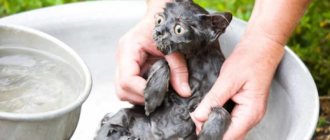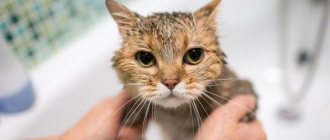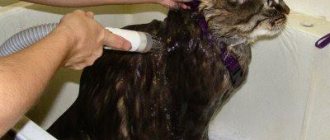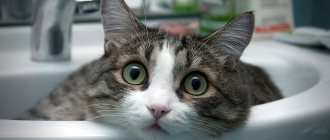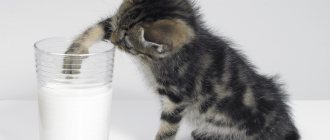It is easier to accustom a small kitten to water procedures than an adult. Owners of a sexually mature animal are faced with the following problem: how to bathe a cat if it is afraid of water.
Experienced breeders advise gradually accustoming your pet to bathing, not forgetting about little tricks.
You should act carefully, without forcing your pet, without showing aggression.
Patience and a friendly attitude will help you find contact even with an adult wayward animal.
Causes of fear
Fear and aversion to water is a natural cat reaction.
Your pet can and should be bathed. The cause of fear is caused by many factors. This may be an unusual environment, too bright light, noise and shouting of people.
Situation
In the bathroom, the animal's movements are constrained, sounds seem sharp, and the sound of water is frightening. Often the owner shouts at the cat if it behaves too aggressively.
The animal does not like that in the bathroom it cannot gain stability, clinging to its claws, while being forcibly held down.
Reaction to shower and hot water
Water flows out of the shower spray noisily and in large streams, which greatly frightens your pet. The animal perceives the hissing pressure of water as a living aggressive creature.
Fluid temperature is not always adjusted (too cold or too hot). When swimming, these factors should be taken into account first.
Tips for the owner: how to wash a cat
To prevent your cat from experiencing stress during bathing, it should be accustomed to the procedure from an early age. Kittens begin to be washed after the complete replacement of milk teeth. At first, they simply dip their paws in water.
How to bathe an adult animal:
- Remove foreign objects from the bathroom, especially those that rattle a lot (buckets, basins, bowls).
- All windows are closed to avoid drafts.
In the bathroom, a towel and pet shampoo are placed at arm's length so that they can be quickly grabbed.- The water temperature and pressure in the mixer are adjusted in advance so as not to frighten the animal during the bathing process.
- The door to the bathroom is closed, sudden sounds and movements are avoided.
- Select a suitable water temperature in the mixer at + 35 ° C, fill the bath one third with liquid.
- The cat is taken by the withers and placed in a container. Wash the paws and body with water (it is important that the liquid does not get into the eyes, nose, ears).
- A small amount of shampoo is squeezed into the palm of your hand, rubbed, applied to the pet’s fur, and foamed. While bathing, the cat is calmed down, talked to calmly and affectionately.
- The foam is washed off with a shower hose, the pressure is set to low so as not to frighten the pet.
If necessary, the entire procedure is repeated twice.
The shampoo is washed off thoroughly: cats lick themselves, and the remains of the detergent can get on the tongue and into the esophagus, harming their health.
Then the pet is dried with a towel; you can dry it with a hairdryer if the cat is not afraid of its noise.
Take care of your eyes
I mean your own. An angry animal can inadvertently hurt you. Do not bring your face closer to the cat, because at any moment it can make an uncontrolled movement that can cause serious wounds. It is clear that the question of how to bathe a cat is very difficult.
If he is terribly afraid of water, try pouring water into a container first, and only then placing the animal there. The cat may be frightened by the sound of running water, so do not turn it on additionally. If you have a long-haired pet, you should comb it thoroughly before bathing.
Preparation for water procedures
Prepare for washing the cat in advance.
Everything necessary for the procedure is laid out nearby, and unnecessary items are removed. Protect your pet's ears with large balls of cotton wool. They should be large enough to cover the ear canal, and after the procedure it will not be difficult to remove them.
To clean the fur, use special shampoos for animals. Detergents for humans are not suitable for them: such products have a different acidity level (PH) and cause irritation on the skin of pets.
Nail trimming
To protect yourself and the animal if it scratches, the cat’s claws are cut before taking a bath. Frightened cats often try to get out of the bathtub by climbing up their owner's arms.
An animal without claws will cause fewer injuries.
Use of special devices
Pet stores sell mesh bags for bathing cats.
The animal is placed in this bag, the headband is fastened around the pet's neck. The device will help pacify your pet: he will not scratch or try to get out of the water.
Large mesh cells do not prevent the penetration of water and detergents into the wool, and bathing will take place without problems. The owner will have both hands free, he can easily soap the pet and rinse off the detergent.
Bath equipment
It is important to prepare the bathroom before bathing your cat at home. A soft mat is placed at the bottom of the bath, which fits tightly to the surface.
Place 2 buckets with a volume of up to 15 liters nearby, wide but shallow, and fill them with warm water. Metal containers create a lot of noise, so it is better to choose plastic. Several caps of concentrated pet detergent are dissolved in one.
It is better not to use basins: they take up a lot of space.
Detergents are placed on the side of the bathroom so that they are easy to reach.
The shower is turned on at the lowest power so that the noise of the water does not frighten the pet. Place old towels or clean sheets nearby, which absorb liquid well after bathing.
Assistant
If a cat bites or runs away from the bath, and there is no special device to restrain it, the help of another family member is needed.
It is easier to bathe a cat without consequences together: the assistant will hold the pet, and the owner will wash the animal without difficulty.
Dry shampoo is the way out
So, the owner decided that bathing the cat is an objective necessity, but the animal does not let itself be handled, bites, scratches and protests against water procedures in every possible way. What to do?
The way out is to use dry shampoo. Even though the effect of such a procedure is not comparable to the cleanliness after washing, treating the fur with this product gives cats less discomfort than bathing.
The powder from the bottle is applied to the animal’s fur coat directly with your hands, making massaging movements with your fingers. After this, so that the product is distributed evenly, the pet is combed. There is no need to wash off the powder with water.
It is important to take precautions when working with dry shampoo. Firstly, the procedure should be carried out in a room where the floors can be washed (it is almost impossible to remove spilled cleaning powder from the carpet without damaging the latter). Secondly, use the product no more than once every six months. Otherwise, the animal will develop an allergic reaction to the shampoo. This leads to a logical disappointing conclusion: dry cleaning products are not a panacea, and sooner or later the cat will have to be washed in the traditional way.
Algorithm for bathing a pet
All actions are performed without haste:
- The animal is picked up, stroked, calmed, and taken to the bathroom. There, the hind legs are fixed with the right hand, holding the animal under the abdomen. With your right hand, grab the front paws, picking up the cat under the ribs.
As soon as the animal is securely fixed, it is carefully immersed in a basin of water, the hind legs are released so that the pet rests them on the bottom of the container.- The front paws are held with the left hand, and the cat is washed with the right. The animal must be immersed in water up to its neck.
- The soap solution is applied to the entire coat (except the head) and the integument is washed with light massaging movements. Areas where vegetation is dense are especially good for cleaning.
- It is not recommended for an overly emotional or fearful pet to wash its hair. This part of the body always remains clean. The muzzle is wiped with a damp towel.
- As soon as bathing in a bucket of soapy water is completed, the cat is transferred to a container with clean liquid. The animal's fur is thoroughly washed to remove any remaining foam.
Water from the shower will help to completely clean the cat of soap.
You can empty the first bucket of dirty water, rinse it, and fill it with clean water. Then the animal is once again transplanted into the container, and its fur is washed well.
After bathing, it is important to thoroughly dry your pet's coat with a clean cloth or hairdryer that absorbs moisture.
The first option is preferable: the noise of the unit is additional stress for the cat.
The owner makes sure that there are no drafts in the house during drying: a wet pet can easily catch a cold. Kittens and older animals with weakened immune systems are especially protected.
A mustachioed pet that has passed all the tests with dignity is given a treat to relieve stress after contact with water.
Water temperature
When preparing a bath for your pet, there are several factors to consider. Firstly, the water should not be too hot, otherwise you risk causing your pet burns of varying degrees of intensity. You should not dip your cat in cold water - he may catch a cold and get sick.
How to bathe a cat without any special consequences for it? Place your pet in the water carefully, trying not to scare it. Make sure that water does not get into the ears. It is not necessary to wash the hair, just wet the rest of the hair and gently rinse it with a special shampoo.
How to teach a cat to bathe
Each owner has his own secrets and approaches to his beloved pet. All of them can be combined into a list of simple recommendations that will reduce the innate fear of water in cats.
Advice from experienced breeders:
It is worth teaching your cat to take water treatments from an early age. From the age of 2 months, the kitten can be placed in a small basin and its paws can be gently washed. Growing up, a seasoned pet will not be afraid of water.- A few days before bathing, an adult animal is placed in an empty basin, having first filled it not with water, but with its favorite toys. At the same time, the animal is given a treat or catnip: the cat will not associate the bathroom and basin with danger.
- As soon as the animal gets used to the empty container, fill it a few centimeters with warm water and put toys in it. The cat is lured with interesting objects or treats, and invited to climb into the basin.
- If your pet is too nervous when taking water procedures, it is better not to keep him in the bathroom for a long time. The animal is lightly rinsed, and bathing is postponed to the next time. The procedure is repeated regularly, do not forget about it.
The pet is combed before washing - this makes washing the fur easier and faster. This removes tangles and dirt, and makes the bathing process easier.
If the cat, after all the tricks, is not used to swimming calmly, contact a groomer. A professional will be able to wash the animal quickly and without consequences, making the task easier for the owner.
About washing a kitten
If everything is fine with the cat and kittens, the mother is properly caring for her offspring. Therefore, healthy babies do not need to have bath days. Experts recommend washing a kitten for the first time when it is 4 months old.
If the baby is very small, the following may happen:
- - the kitten will be very scared and will then resist wet procedures;
- - a nursing mother does not recognize a baby who smells of shampoo;
- - the kitten does not have well-established thermoregulation, and therefore it will simply freeze and get sick.
If the kitten has been vaccinated, it is not washed for 2 weeks.

